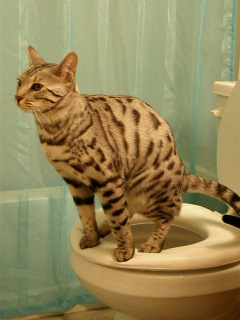The Dangers of Flushing Cat Poop Down Your Toilet - Tips for Better Handling
The Dangers of Flushing Cat Poop Down Your Toilet - Tips for Better Handling
Blog Article
We've come across the article pertaining to How to Dispose of Cat Poop and Litter Without Plastic Bags below on the web and concluded it made perfect sense to share it with you on my blog.

Intro
As cat proprietors, it's necessary to bear in mind how we take care of our feline pals' waste. While it might seem hassle-free to flush pet cat poop down the toilet, this technique can have detrimental repercussions for both the setting and human health and wellness.
Ecological Impact
Flushing feline poop presents hazardous microorganisms and parasites right into the water, positioning a substantial risk to aquatic environments. These contaminants can negatively affect aquatic life and compromise water high quality.
Wellness Risks
In addition to environmental worries, purging pet cat waste can additionally posture wellness dangers to people. Pet cat feces may contain Toxoplasma gondii, a bloodsucker that can cause toxoplasmosis-- a possibly severe illness, specifically for expecting females and individuals with damaged immune systems.
Alternatives to Flushing
Luckily, there are safer and much more liable ways to deal with pet cat poop. Think about the adhering to options:
1. Scoop and Dispose in Trash
One of the most common approach of dealing with cat poop is to scoop it into a biodegradable bag and throw it in the trash. Be sure to make use of a devoted trash inside story and get rid of the waste quickly.
2. Use Biodegradable Litter
Select eco-friendly feline trash made from materials such as corn or wheat. These clutters are environmentally friendly and can be securely disposed of in the garbage.
3. Hide in the Yard
If you have a backyard, take into consideration hiding pet cat waste in a marked location away from vegetable gardens and water resources. Make certain to dig deep adequate to prevent contamination of groundwater.
4. Install a Pet Waste Disposal System
Invest in a pet garbage disposal system especially made for cat waste. These systems use enzymes to break down the waste, reducing odor and ecological impact.
Conclusion
Liable pet ownership extends past providing food and shelter-- it also entails correct waste management. By refraining from flushing feline poop down the bathroom and choosing alternative disposal methods, we can decrease our ecological footprint and protect human wellness.
Why You Should NEVER Flush Cat Poop (and/or Litter) Down Your Toilet
The Problem with Litter
The main function of litter is to solidify and adhere to your cat’s waste. While this makes litter excellent for collecting cat poop and urine, it’s also the exact property that makes it a nightmare when flushed down the toilet.
Cat litter can and will clog pipes. There is non-clumping litter, but it’s still quite heavy and can build up in pipes. This is true even of supposed “flushable litter.”
The problems only compound when the litter is already clumped into cat waste. Toilet paper is among the more flushable things, and even too much of that will clog a toilet.
The Problem with Cat Poop
Sewers and septic systems are designed with human waste in mind. The microbes that help break down human waste don’t work on cat waste. Additionally, cat poop plays host to the parasite Toxoplasma gondii.
When flushed, this parasite can enter the environment in places it was never meant to, posing a risk to pregnant women, their unborn children, and other people with compromised immune systems. While it might not seem possible, flushing cat poop can indeed introduce this parasite to the public water supply.
These reasons are why, even if you’ve trained your cat to go on the toilet and flush, which is possible, it’s still not a good idea. Also, pregnant women and the immunocompromised shouldn’t change litter, either.
How to Handle Litter
The best way to handle litter is to simply put it in a plastic bag and place it in the trash. Avoiding environmental risks and possible plumbing damage is worth the extra effort.
You can also invest in devices that seal away your cat’s waste in a separate compartment, so you don’t have to change the litter nearly as often. They’re also safer for pet owners because they limit the possibility of Toxoplasma gondii exposure.
Disposing of litter the old-fashioned way will ensure you won’t have to worry about any issues that flushing the waste can potentially cause.
Take Care of Clogged Pipes with Stephens Plumbing, Heating & Air Conditioning
The reasons you should never flush cat poop down your toilet are numerous, but sometimes the inevitable happens despite your best efforts.
Stephens Plumbing, Heating & Air Conditioning is ready to help if you’re experiencing litter-blocked plumbing. Whether you need us in an emergency or want to schedule regular maintenance, we’re here for you.
https://www.stephensplumbing.net/bathroom-plumbing/never-flush-cat-poop-down-your-toilet/

Do you enjoy reading about How to Dispose of Cat Poop and Litter Without Plastic Bags? Try leaving a short review directly below. We will be interested to find out your thinking about this posting. In hopes that you come back again soon. Appreciated our blog? Please share it. Let another person discover it. Thanks for your time. Visit us again soon.
Call Today Report this page